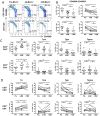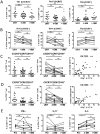Dimethyl Fumarate Selectively Reduces Memory T Cells and Shifts the Balance between Th1/Th17 and Th2 in Multiple Sclerosis Patients
- PMID: 28258191
- PMCID: PMC5464403
- DOI: 10.4049/jimmunol.1601532
Dimethyl Fumarate Selectively Reduces Memory T Cells and Shifts the Balance between Th1/Th17 and Th2 in Multiple Sclerosis Patients
Abstract
Dimethyl fumarate (DMF; trade name Tecfidera) is an oral formulation of the fumaric acid ester that is Food and Drug Administration approved for treatment of relapsing-remitting multiple sclerosis. To better understand the therapeutic effects of Tecfidera and its rare side effect of progressive multifocal leukoencephalopathy, we conducted cross-sectional and longitudinal studies by immunophenotyping cells from peripheral blood (particularly T lymphocytes) derived from untreated and 4-6 and 18-26 mo Tecfidera-treated stable relapsing-remitting multiple sclerosis patients using multiparametric flow cytometry. The absolute numbers of CD4 and CD8 T cells were significantly decreased and the CD4/CD8 ratio was increased with DMF treatment. The proportions of both effector memory T cells and central memory T cells were reduced, whereas naive T cells increased in treated patients. T cell activation was reduced with DMF treatment, especially among effector memory T cells and effector memory RA T cells. Th subsets Th1 (CXCR3+), Th17 (CCR6+), and particularly those expressing both CXCR3 and CD161 were reduced most significantly, whereas the anti-inflammatory Th2 subset (CCR3+) was increased after DMF treatment. A corresponding increase in IL-4 and decrease in IFN-γ and IL-17-expressing CD4+ T cells were observed in DMF-treated patients. DMF in vitro treatment also led to increased T cell apoptosis and decreased activation, proliferation, reactive oxygen species, and CCR7 expression. Our results suggest that DMF acts on specific memory and effector T cell subsets by limiting their survival, proliferation, activation, and cytokine production. Monitoring these subsets could help to evaluate the efficacy and safety of DMF treatment.
Copyright © 2017 by The American Association of Immunologists, Inc.
Figures





References
-
- Stadelmann C, Brück W. Interplay between mechanisms of damage and repair in multiple sclerosis. Journal of neurology. 2008;255:12–18. - PubMed
-
- Geginat J, Lanzavecchia A, Sallusto F. Proliferation and differentiation potential of human CD8+ memory T-cell subsets in response to antigen or homeostatic cytokines. Blood. 2003;101:4260–4266. - PubMed
-
- Teixeira AM, Rama L, Carvalho HM, Borges G, Carvalheiro T, Gleeson M, Alves F, Trindade H, Paiva A. Changes in naive and memory T-cells in elite swimmers during a winter training season. Brain, behavior, and immunity. 2014;39:186–193. - PubMed
-
- Lyck R, Engelhardt B. Going against the tide–how encephalitogenic T cells breach the blood-brain barrier. Journal of vascular research. 2012;49:497–509. - PubMed
-
- Sallusto F, Geginat J, Lanzavecchia A. Central memory and effector memory T cell subsets: function, generation, and maintenance. Annu Rev Immunol. 2004;22:745–763. - PubMed
Publication types
MeSH terms
Substances
Grants and funding
LinkOut - more resources
Full Text Sources
Other Literature Sources
Research Materials

